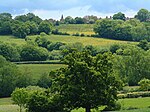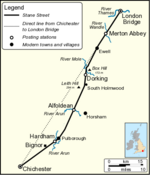Smokejack Clay Pit
Geological Conservation Review sitesGeology of South-East EnglandSites of Special Scientific Interest in Surrey

Smokejack Clay Pit is a 56-hectare (140-acre) geological Site of Special Scientific Interest east of Cranleigh in Surrey. It is a Geological Conservation Review site.This site exposes Lower Cretaceous rocks of the Weald Clay Group, which have been studied since 1983. Fossils of six orders of insects have been recorded and an unusual level of details has been preserved. It is the best Weald Clay reptile site, with crocodile teeth, coprolites and part of an Iguanodon. The holotype specimen of the fish eating theropod dinosaur, Baryonyx walkeri was discovered on the site in January 1983.
Excerpt from the Wikipedia article Smokejack Clay Pit (License: CC BY-SA 3.0, Authors, Images).Smokejack Clay Pit
Horsham Road, Mole Valley Abinger
Geographical coordinates (GPS) Address Nearby Places Show on map
Geographical coordinates (GPS)
| Latitude | Longitude |
|---|---|
| N 51.125 ° | E -0.415 ° |
Address
Horsham Road
RH5 5RL Mole Valley, Abinger
England, United Kingdom
Open on Google Maps






